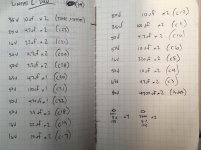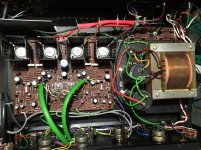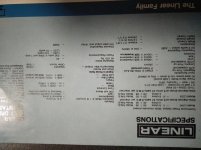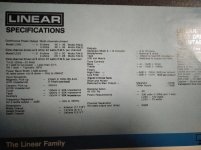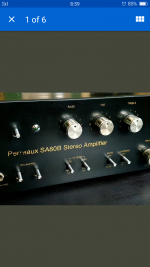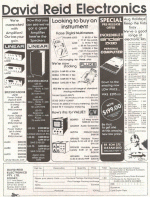Hello team, I've lurked on various audio repair forums a long long time. I'm finally ready, (I think) to get involved in a recap.
The subject at hand is a NZ made, likely in the 'heyday' for these vintage amps we know and love. Linear L-240 is the manufacturer and model.
The only 'data' I can find on this amplifier is here:
Happy birthday L240 • Heat • Public Address
Manufacturer may be mentioned here:
LINEAR Electronics Ltd Auckland New Zealand | Audiokarma Home Audio Stereo Discussion Forums
So the hopes of finding a datasheet are slim to impossible. Cool. Now I'm fairly new to soldering, but have access to a slick temperature regulated iron and I've been reading the how-to and tips for years. I think I'm ready to tackle a project. I also have a few friends who do this professionally, so I have the luxury of a few guides.
Now the amplifier worked momentarily, then began a feedback noise coming through. I suspect its the big capacitors in the power section, but as I'm learning, I would like to go through a full recap, to get a bit of practice in.
I've made a list of the capacitors. Are there any other things I should look at replacing? I've done some reading that suggests as long as capacitance remains the same, upping the voltage is okay. I've also read suggestions to keep the physical size of the capacitors the same, so that the legs pop in the circuit board without much mangling.
How would I go about measuring my current capacitors size to compare to the modern day offerings? Is there a physical sizing guide? Use a micrometer? Just a ruler for height / diameter? Are the physical sizes listed of the capacitors on mouser and such?
Any other challenges you wish to point out are helpful too.
I've included a couple photos of the project.
Dustin
The subject at hand is a NZ made, likely in the 'heyday' for these vintage amps we know and love. Linear L-240 is the manufacturer and model.
The only 'data' I can find on this amplifier is here:
Happy birthday L240 • Heat • Public Address
Manufacturer may be mentioned here:
LINEAR Electronics Ltd Auckland New Zealand | Audiokarma Home Audio Stereo Discussion Forums
So the hopes of finding a datasheet are slim to impossible. Cool. Now I'm fairly new to soldering, but have access to a slick temperature regulated iron and I've been reading the how-to and tips for years. I think I'm ready to tackle a project. I also have a few friends who do this professionally, so I have the luxury of a few guides.
Now the amplifier worked momentarily, then began a feedback noise coming through. I suspect its the big capacitors in the power section, but as I'm learning, I would like to go through a full recap, to get a bit of practice in.
I've made a list of the capacitors. Are there any other things I should look at replacing? I've done some reading that suggests as long as capacitance remains the same, upping the voltage is okay. I've also read suggestions to keep the physical size of the capacitors the same, so that the legs pop in the circuit board without much mangling.
How would I go about measuring my current capacitors size to compare to the modern day offerings? Is there a physical sizing guide? Use a micrometer? Just a ruler for height / diameter? Are the physical sizes listed of the capacitors on mouser and such?
Any other challenges you wish to point out are helpful too.
I've included a couple photos of the project.
Dustin
Attachments
With equipment this old there are likely to be solder joints that have gone cold. Whatever you do with replacing capacitors do this in stages so you can test and back track if anything goes wrong.
The large ones in the power supply look to be good quality parts, like some of those on the pcb these have black insulating jackets which are newer types than those having grey jackets.
Check also that any of the control pots is not contributing to the noise. The tracks in these could need a spray.
The large ones in the power supply look to be good quality parts, like some of those on the pcb these have black insulating jackets which are newer types than those having grey jackets.
Check also that any of the control pots is not contributing to the noise. The tracks in these could need a spray.
A couple of other points - the charging currents to the large capacitors from the bridge rectifier are substantial and ideally those from the transformer and those to the capacitors should reduce the 50 Hz radiated fields.
The transformer secondary wire connection to the bridge looks to have been badly soldered and the copper wire seems to have some oxidation. The red wire jointing the extreme connections to the main supply capacitors should be moved across towards the transformer. There is a slight burn on one of the earth wires indicating some previous work has been done. The green signal cable looks to be an upgrade possibly the brand "Musiflex" and I suspect the amplifier predates the time when this product arrived.
The transformer secondary wire connection to the bridge looks to have been badly soldered and the copper wire seems to have some oxidation. The red wire jointing the extreme connections to the main supply capacitors should be moved across towards the transformer. There is a slight burn on one of the earth wires indicating some previous work has been done. The green signal cable looks to be an upgrade possibly the brand "Musiflex" and I suspect the amplifier predates the time when this product arrived.
@mjona thanks for the tips, and noticing a few things suggesting previous work.
The darker caps in my picture are navy coloured "Elna". Most of the rest are light grey Elna. There are a couple of grey Soanar. Some light blue ones Jeoudah, and a couple of even lighter shade of blue, unidentifiable manufacturer until I pull them out.
As far as the sound being produced by the amplifier, it was a 'feedback' humming that would start after 5-15 minutes of being powered on. If I turned the volume all the way down, the feedback would still be present. iirc, the only way to get the feedback sound to go away was switching the speaker set away. Tried the other speaker set just to be sure, receiving the same results.
I've made a list of the capacitors required (qty. 35) for the whole unit. I suppose you're suggesting the power caps to be not an issue, so I'm tempted to leave those off, as they are nearly doubling the cost of the order. I'll have to have a think on those.
This is my list if you feel like a glance. I've taken into consideration the diameter of the caps, to try to get the same, or similar.
Blocked
I'm pretty ready to order and dive into this. Ordering a few other parts for a couple other projects, but the list above is for this amplifier exclusively.
The darker caps in my picture are navy coloured "Elna". Most of the rest are light grey Elna. There are a couple of grey Soanar. Some light blue ones Jeoudah, and a couple of even lighter shade of blue, unidentifiable manufacturer until I pull them out.
As far as the sound being produced by the amplifier, it was a 'feedback' humming that would start after 5-15 minutes of being powered on. If I turned the volume all the way down, the feedback would still be present. iirc, the only way to get the feedback sound to go away was switching the speaker set away. Tried the other speaker set just to be sure, receiving the same results.
I've made a list of the capacitors required (qty. 35) for the whole unit. I suppose you're suggesting the power caps to be not an issue, so I'm tempted to leave those off, as they are nearly doubling the cost of the order. I'll have to have a think on those.
This is my list if you feel like a glance. I've taken into consideration the diameter of the caps, to try to get the same, or similar.
Blocked
I'm pretty ready to order and dive into this. Ordering a few other parts for a couple other projects, but the list above is for this amplifier exclusively.
I normally buy from Jaycar stores or online from RS Components who don't charge delivery costs if you have an account and order online but the do have minimum quantity orders.
Recently I ordered some FET's from Mouser NZ the package was tiny but the delivery costs were from a warehouse based in the USA and these were too much to the point that am not going to do that again. You might find your situation with Digikey NZ to be quite costly as well.
Where your capacitors have the same uF value but differ in voltage you could make the ratings for these all the same. Some of the higher voltage ones may be taller or slightly greater in lead spacing. You could buy a pair of Nippon Chemi-con 4700uF 50V rated capacitors for just over $20 -assuming your supply rails are less than 50V. You might also look up Surplustronics to see if they have any suitable capacitors among their surplus stock purchase holdings.
Recently I ordered some FET's from Mouser NZ the package was tiny but the delivery costs were from a warehouse based in the USA and these were too much to the point that am not going to do that again. You might find your situation with Digikey NZ to be quite costly as well.
Where your capacitors have the same uF value but differ in voltage you could make the ratings for these all the same. Some of the higher voltage ones may be taller or slightly greater in lead spacing. You could buy a pair of Nippon Chemi-con 4700uF 50V rated capacitors for just over $20 -assuming your supply rails are less than 50V. You might also look up Surplustronics to see if they have any suitable capacitors among their surplus stock purchase holdings.
Apologies for the upside down pic. I have 3 of these amps in varying degrees of condition. Bit of nostalgia as I grew up listening to one, which then became mine. Sadly that one was wrecked at a party when I wasn't about. One I haven't seen and is still in a box packaged up at my parents house, off trade me. Supposedly working but I'm poor physical condition. The third, I have here and is working as it should, in good condition but prob in need of a recap.
This integrated shares a striking physical resemblance to Sansui AU4900, and from memory the specs were very similar (I may have wrong Sansui model here).
Have also tried myself to research these but there is literally nothing out there apart from the link mentioned in the original post.
Nice looking amp and nice vintage sound.
This integrated shares a striking physical resemblance to Sansui AU4900, and from memory the specs were very similar (I may have wrong Sansui model here).
Have also tried myself to research these but there is literally nothing out there apart from the link mentioned in the original post.
Nice looking amp and nice vintage sound.
Check out this Perreaux that also looks similar, but I guess the look is typical of that era. In past research I've also associated these Linear amps to the Rait amplifier brand from Christchurch, but that was only based on visuals of some of the internals of his gear. Whether there is a connection I'm not sure.
Attachments
Last edited:
Hello Dustin!
Let me start by saying that the feedback noise you are experiencing is unlikely to be related to the big caps in the power supply.
I have been repairing domestic and pro audio equipment for 40+ years and I'm pretty confident it won't be the main filter caps.
It *may* be some of the smaller signal path caps, but I wouldn't start replacing them willy nilly on the chance that it is.
Better to fault-find and actually work out the source the problem then just deal to that.
I have worked on quite a few Linear amps, and they're a solid design with a fairly straight forward signal path and universal layout.
There's a lot of talk around the electronics scene about amplifiers and pre-amps needing to be recapped - and it's not always the case.
Yes caps do dry out over time, but I have worked on amps that are 60 years old and the caps are just fine, and conversely amps which are only a few years old that have needed some of them replacing due to premature failure.
The idea that blanket replacement of capacitors is a 'cure-all' to every fault an amp may ever had is a falsehood, and in some situations you can make things worse by going through and changing them all out - not to mention the unnecessary lightening of your wallet.
I don't know where you are in the country, but I am in Wellington so if you want some assistance with diagnosing the actual fault I would be more than happy to assist.
Let me start by saying that the feedback noise you are experiencing is unlikely to be related to the big caps in the power supply.
I have been repairing domestic and pro audio equipment for 40+ years and I'm pretty confident it won't be the main filter caps.
It *may* be some of the smaller signal path caps, but I wouldn't start replacing them willy nilly on the chance that it is.
Better to fault-find and actually work out the source the problem then just deal to that.
I have worked on quite a few Linear amps, and they're a solid design with a fairly straight forward signal path and universal layout.
There's a lot of talk around the electronics scene about amplifiers and pre-amps needing to be recapped - and it's not always the case.
Yes caps do dry out over time, but I have worked on amps that are 60 years old and the caps are just fine, and conversely amps which are only a few years old that have needed some of them replacing due to premature failure.
The idea that blanket replacement of capacitors is a 'cure-all' to every fault an amp may ever had is a falsehood, and in some situations you can make things worse by going through and changing them all out - not to mention the unnecessary lightening of your wallet.
I don't know where you are in the country, but I am in Wellington so if you want some assistance with diagnosing the actual fault I would be more than happy to assist.
Check out this Perreaux that also looks similar, but I guess the look is typical of that era. In past research I've also associated these Linear amps to the Rait amplifier brand from Christchurch, but that was only based on visuals of some of the internals of his gear. Whether there is a connection I'm not sure.
There was quite a bit of similarity between units that were designed and made here in NZ in the 70s and 80s.
I suspect a degree of copying went on - a manufacturer would style their design based on the lines of another's machine - much like all the Japanese cars of the 80s all had the same square lines.
Linear was an in-house brand made and distributed by David Reid Electronics of Birkenhead in Auckland. They also produced equipment under the 'Laser' brand.
Thanks for the upload of the Linear user manual!

@mjona thanks for the tips, and noticing a few things suggesting previous work.
As far as the sound being produced by the amplifier, it was a 'feedback' humming that would start after 5-15 minutes of being powered on. If I turned the volume all the way down, the feedback would still be present. iirc, the only way to get the feedback sound to go away was switching the speaker set away. Tried the other speaker set just to be sure, receiving the same results.
Someone has had a go at the power supply earth arrangements. The transformer centre tap has been cut short to connect to one of the supply capacitor tags and the wire to earth is common to all connecting wire. The only wire connecting the two capacitor to earth tags should be the centre tap and the wire to chassis earth. This allows the charging currents to do battle with each other at one point.
The other earth connections should be taken from a T junction - by adding a separate wire and staggering the leads along the length so the most sensitive one for the input etc is last in the queue. The idea is not to have dirty currents flowing over the top of clean ones.
...Linear was an in-house brand made and distributed by David Reid Electronics of Birkenhead in Auckland....
https://worldradiohistory.com/hd2/I...-IDX/IDX/ETI 1981-08 August-OCR-Page-0072.pdf
Attachments
David Reid Electronics started out as a NZ-based company in the 1950s and expanded into Australia some years later. Thanks for the advertisement!
Back in 1976 when I was living in Auckland David Reid Electronics had only one store in Airedale Street, a short walk from the offices where I worked. I bought all the parts I needed to build Linsley-Hood's 1969 amplifier bar the transformer. I think the company name was D.J. Reid before they branched out to Australia.
I remember the Linear Amplifiers coming on the market but although they were not that expensive I could not justify the purchase against other family priorities.
David Reid Electronics later offered a MOSFET amplifier as a kit. The boards for these were hand drawn and rough. I think when Dick Smith Electronics started up here the competition was too much for David Reid and they ceased trading.
I remember the Linear Amplifiers coming on the market but although they were not that expensive I could not justify the purchase against other family priorities.
David Reid Electronics later offered a MOSFET amplifier as a kit. The boards for these were hand drawn and rough. I think when Dick Smith Electronics started up here the competition was too much for David Reid and they ceased trading.
Back in 1976 when I was living in Auckland David Reid Electronics had only one store in Airedale Street, a short walk from the offices where I worked. I bought all the parts I needed to build Linsley-Hood's 1969 amplifier bar the transformer. I think the company name was D.J. Reid before they branched out to Australia.
I remember the Linear Amplifiers coming on the market but although they were not that expensive I could not justify the purchase against other family priorities.
David Reid Electronics later offered a MOSFET amplifier as a kit. The boards for these were hand drawn and rough. I think when Dick Smith Electronics started up here the competition was too much for David Reid and they ceased trading.
Yes, the company was known as David J Reid (NZ) Ltd in the early days.
Dick Smith entered the NZ market in 1981.
A few years later I worked in one of their stores for 6 months after leaving school.
In 1992, they bought out David Reid Electronics, and slowly started replacing the quality parts and tools that Reid's were known for with cheap chinese rubbish.
Eventually, where it was appropriate, Reid stores were turned into Dick stores Others (usually ones that were too close to an existing Dick store) were simply closed down.
David Reid Electronics started out as a NZ-based company in the 1950s and expanded into Australia some years later....
I read A. Bertram Chandler. I know there's ships run from Au to NZ now and then, so the one land infects the other. (ABC has a long passage about commuting to NZ with empty ore-haulers and being blown onto the rocks...)
Yes, I see Reid's operation met Smith's operation with expectable outcome.
Yes, the company was known as David J Reid (NZ) Ltd in the early days.
Dick Smith entered the NZ market in 1981.
A few years later I worked in one of their stores for 6 months after leaving school.
In 1992, they bought out David Reid Electronics, and slowly started replacing the quality parts and tools that Reid's were known for with cheap chinese rubbish.
Eventually, where it was appropriate, Reid stores were turned into Dick stores Others (usually ones that were too close to an existing Dick store) were simply closed down.
An acquaintance of mine worked at Dick Smith's branch in the vicinity of the Auckland area bus terminal. I had to walk that way to catch the bus home.
Paul told me there were no such things as breaks for tea and lunch. In the end he left to work for John Gilbert and then for Ray at Microfix who stocked parts like WIMA and ERO capacitors and Roederstein metal film resistors.
- Status
- This old topic is closed. If you want to reopen this topic, contact a moderator using the "Report Post" button.
- Home
- Amplifiers
- Solid State
- Linear L-240 recap and...
